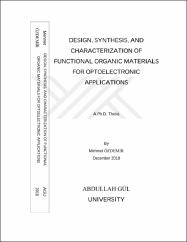| dc.description.abstract | The development of ?-conjugated semiconducting small molecules and polymers as functional organic materials is an emerging and continuously growing research area in (opto)electronics. Semiconducting small molecules and polymers are envisioned as key components of high-performance organic thin-film transistors (OTFTs) and photovoltaics (OPVs) for next-generation (opto)electronic technologies such as plastic logic circuits, flexible displays, rollable solar panels, and electronic skins. The main motivations in continuously designing and synthesizing new ?-frameworks in the past few decades do not only include improving charge-transport and device characteristics and realizing novel functions, but also better understanding and addressing molecular structure- (opto)electronic property-electrical performance relationships. This thesis studies and explores the rational design, synthesis, and characterization of novel ?-conjugated semiconductors with varied chemical structures for OTFT and OPV applications. In the first chapter, the general concepts and fundamentals of ?-conjugated semiconducting materials and organic electronic devices are discussed along with a deep literature review focusing on most up-to-date results in the field. OTFTs are classified and described based on the major charge carrier type as n-channel, p-channel, and ambipolar devices, which is closely related to the semiconductor’s ?-structure. The mechanism of OPVs’ working principle is also reviewed describing the electronic/structural effects of semiconductor ?-structure on these devices. The second chapter deals with the design, synthesis, and characterization of a series of new indeno[1,2-b]fluorene-6,12-dione-thiophene small molecules, DDTIFDKT, 2EH-TIFDKT, and 2OD-TIFDKT that consist of highly ?-conjugated donor–acceptor molecular architectures based on indeno[1,2-b]fluorene-6,12-dione acceptor unit and thiophene donor units. The semiconductor structures have low band gaps of 1.7–1.8 eV, and they are ?,?-end-functionalized with linear –n-C12H25 chains or swallow-tail 2-ethylhexyl-/2-octyldodecyl chains. The detailed study on the effects of alkyl chain size and orientation on the optoelectronic properties, intermolecular cohesive forces, thin-film microstructures, and charge transport performances of the new semiconductors, which revealed crucial structure–property–function relationships. The solution-processed OTFT devices of the current semiconductors, 2EH-TIFDKT and 2OD-TIFDKT, exhibit excellent ambipolar behavior with carrier mobilities of 0.04–0.12 cm2 /V·s and 0.0003–0.02 cm2 /V·s for electrons and holes, respectively, and Ion/Ioff ratios of 105 to 106 , which indicates two–three orders of carrier mobility enhancement compared to those of solution-processed ß-substituted counterparts. In the rational design of the new molecules, the repositioning of the insulating ß-substituents to molecular termini is found to significantly enhance the ?-core planarity while maintaining a good solubility, which improved the charge-transport characteristics. In the third chapter, three novel solution-processable BODIPY-based semiconducting materials (BDY-3T-BDY, BDY-4T-BDY, and BDY-PhAc-BDY) were synthesized. All these materials displayed n-channel OTFT device operation. BDY-4TBDY based bottom-gate/top-contact devices exhibited extremely high Ion/Ioff ratios of >108 and electron mobilities of up to 0.01 cm2 /V·s. Up to now, this result is one of the best charge-carrier mobilities among the known BODIPY based materials in the literature. BDY-3T-BDY showed electron mobilities of 2.7×10-4 cm2 /V·s and Ion/Ioff ratio of 9.6×105 . BDY- PhAc –BDY displayed electron mobilities of 0.004 cm2 /V·s and Ion/Ioff ratio of 105 -106 .The chemical structures, optical/electrochemical properties, and thin-film microstructures for these semiconductors were fully characterized by 1H/13C NMR, mass spectrometry, cyclic voltammetry, UV-Vis absorption spectroscopy, thermogravimetric, atomic force microscope (AFM) and X-ray diffraction (XRD) analysis. In the fourth chapter, boron containing polymers P(2OD-TBDY-T) and P(2ODTBDY-TT) were synthesized and their optoelectronic properties in OTFT and OPV devices were investigated. P(2OD-TBDY-T) based bottom-gate/top-contact OTFT devices exhibited Ion/Ioff ratios of >108 and hole mobilities of 0.005 cm2 /V·s. Inverted BHJOPVs employing (P(2OD-TBDY-T):PC71BM active layer exhibited excellent power conversion efficiencies (PCE) of 6.2% with a short-circuit current of 16.6 mA/cm2 . These results showed that rationally designed BODIPY based donor copolymers could be used in high-performance OPVs. The findings presented in this thesis suggest that through computational modeling guided rational design and synthetic tailoring, physicochemical/optoelectronic properties and electron/hole transport characteristics of molecular and polymeric semiconductors can be significantly improved realizing new functions. We believe that our results will provide key structural/electronic information and additional motivation in the field to investigate and optimize structurally varied semiconductors for high-performance organic (opto)electronic applications. Keywords: Organic Semiconductors, Solution-Processable Molecules and Polymers, Organic Thin-Film Transistors (OTFTs), Organic Photovoltaics (OPVs) | en_US |


















